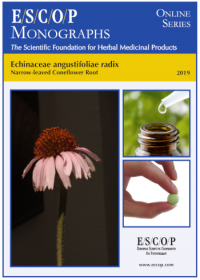
ESCOP monographs The Scientific Foundation for Herbal Medicinal Products. Online series. Echinaceae angustifoliae radix (Narrow-leaved coneflower root). Exeter: ESCOP; 2019.
SUMMARY
The herbal monograph selects and summarises scientific studies and
textbooks regarding efficacy, dosage and safety to support the
therapeutic uses of narrow-leaved coneflower root.
This herbal drug by definition consists of the dried, whole or cut, underground parts of Echinacea angustifolia DC.
Studies with its characteristic constituents echinacoside,
alkamides, polysaccharides and glycoproteins are included. The
therapeutic indications are adjuvant therapy and prophylaxis of
recurrent infections of the upper respiratory tract (common cold).
Administration of narrow-leaved coneflower root addresses
posology; duration of use; contra-indications; special warnings; special
precautions for use; interactions with other medicinal products; other
forms of interaction; use in pregnancy and lactation; effects on ability
to drive; undesirable effects and overdose.
In vitro experiments demonstrated immunostimulatory, immunomodulatory, antioxidant, antiviral and antifungal effects. In vivo experiments showed phagocytosis-stimulating and immunomodulating properties.
A pharmacological study in humans for the treatment of the
common cold concerned experimental rhinovirus (HRV type 39) infections. A
placebo controlled clinical study indicated a 13% relative reduction of
infection in the narrow-leaved coneflower root group.
Pharmacokinetic studies assessed in healthy volunteers, showed
that alkamides were rapidly absorbed. Preclinical safety data were
assessed in toxicity studies. Safety data were assessed in human
studies, where mild adverse events were reported.
The selection of literature cited in the monograph is aimed at
bringing together relevant information about the possible physiological
roles of narrow-leaved coneflower root and its major constituents.
KEYWORS
- Echinaceae angustifoliae radix
- Narrow-leaved coneflower root
- Echinacea angustifolia DC.
- Adjuvant therapy and prophylaxis of recurrent Infections of the upper respiratory tract (common cold).



